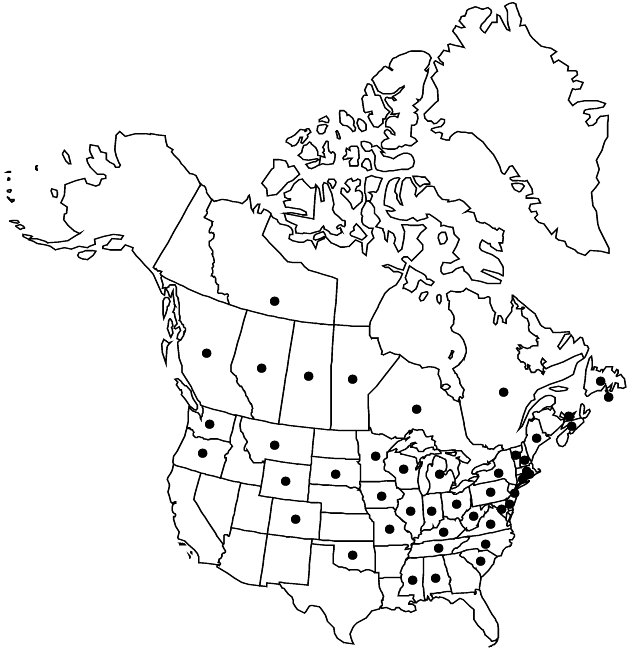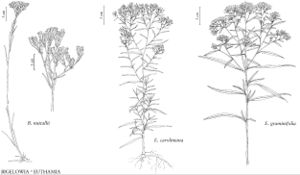Difference between revisions of "Euthamia graminifolia"
Trans. Amer. Philos. Soc., n. s. 7: 325. 1840.
FNA>Volume Importer |
imported>Volume Importer |
||
| (3 intermediate revisions by 2 users not shown) | |||
| Line 8: | Line 8: | ||
}} | }} | ||
|common_names=Common goldentop;verge d’or à feuilles de graminées | |common_names=Common goldentop;verge d’or à feuilles de graminées | ||
| + | |special_status={{Treatment/ID/Special_status | ||
| + | |code=F | ||
| + | |label=Illustrated | ||
| + | }}{{Treatment/ID/Special_status | ||
| + | |code=E | ||
| + | |label=Endemic | ||
| + | }} | ||
|basionyms={{Treatment/ID/Basionym | |basionyms={{Treatment/ID/Basionym | ||
|name=Chrysocoma graminifolia | |name=Chrysocoma graminifolia | ||
|authority=Linnaeus | |authority=Linnaeus | ||
| + | |rank=species | ||
|publication_title=Sp. Pl. | |publication_title=Sp. Pl. | ||
|publication_place=2: 841. 1753 | |publication_place=2: 841. 1753 | ||
| Line 17: | Line 25: | ||
|name=Euthamia fastigiata | |name=Euthamia fastigiata | ||
|authority=Bush | |authority=Bush | ||
| + | |rank=species | ||
}} {{Treatment/ID/Synonym | }} {{Treatment/ID/Synonym | ||
|name=Euthamia floribunda | |name=Euthamia floribunda | ||
|authority=Greene | |authority=Greene | ||
| + | |rank=species | ||
}} {{Treatment/ID/Synonym | }} {{Treatment/ID/Synonym | ||
|name=Euthamia graminifolia var. major | |name=Euthamia graminifolia var. major | ||
|authority=(Michaux) Moldenke | |authority=(Michaux) Moldenke | ||
| + | |rank=variety | ||
}} {{Treatment/ID/Synonym | }} {{Treatment/ID/Synonym | ||
|name=Euthamia graminifolia var. nuttallii | |name=Euthamia graminifolia var. nuttallii | ||
|authority=(Greene) Sieren | |authority=(Greene) Sieren | ||
| + | |rank=variety | ||
}} {{Treatment/ID/Synonym | }} {{Treatment/ID/Synonym | ||
|name=Euthamia hirtipes | |name=Euthamia hirtipes | ||
|authority=(Linnaeus) Salisbury | |authority=(Linnaeus) Salisbury | ||
| + | |rank=species | ||
}} {{Treatment/ID/Synonym | }} {{Treatment/ID/Synonym | ||
|name=Solidago camporum var. tricostata | |name=Solidago camporum var. tricostata | ||
|authority=Lunell | |authority=Lunell | ||
| + | |rank=variety | ||
}} {{Treatment/ID/Synonym | }} {{Treatment/ID/Synonym | ||
|name=Solidago graminifolia var. major | |name=Solidago graminifolia var. major | ||
|authority=(Michaux) Fernald | |authority=(Michaux) Fernald | ||
| + | |rank=variety | ||
}} {{Treatment/ID/Synonym | }} {{Treatment/ID/Synonym | ||
|name=Solidago graminifolia var. septentrionalis | |name=Solidago graminifolia var. septentrionalis | ||
|authority=Fernald | |authority=Fernald | ||
| + | |rank=variety | ||
}} {{Treatment/ID/Synonym | }} {{Treatment/ID/Synonym | ||
|name=Solidago hirtipes | |name=Solidago hirtipes | ||
| − | |authority= | + | |authority= |
| + | |rank=species | ||
}} {{Treatment/ID/Synonym | }} {{Treatment/ID/Synonym | ||
|name=Solidago lanceolata | |name=Solidago lanceolata | ||
| − | |authority= | + | |authority= |
| + | |rank=species | ||
}} | }} | ||
|hierarchy=Asteraceae;Asteraceae tribe Astereae;Euthamia;Euthamia graminifolia | |hierarchy=Asteraceae;Asteraceae tribe Astereae;Euthamia;Euthamia graminifolia | ||
| Line 59: | Line 77: | ||
|elevation=0–900 m | |elevation=0–900 m | ||
|distribution=St. Pierre and Miquelon;Alta.;B.C.;Man.;Nfld. and Labr. (Nfld.);N.W.T.;N.S.;Ont.;P.E.I.;Que.;Sask.;Ala.;Colo.;Conn.;Del.;Ill.;Ind.;Iowa;Ky.;Maine;Md.;Mass.;Mich.;Minn.;Miss.;Mo.;Mont.;N.H.;N.J.;N.Y.;N.C.;Ohio;Okla.;Oreg.;Pa.;R.I.;S.C.;S.Dak.;Tenn.;Vt.;Va.;Wash.;Wis.;W.Va.;Wyo.;introduced in Europe;Asia. | |distribution=St. Pierre and Miquelon;Alta.;B.C.;Man.;Nfld. and Labr. (Nfld.);N.W.T.;N.S.;Ont.;P.E.I.;Que.;Sask.;Ala.;Colo.;Conn.;Del.;Ill.;Ind.;Iowa;Ky.;Maine;Md.;Mass.;Mich.;Minn.;Miss.;Mo.;Mont.;N.H.;N.J.;N.Y.;N.C.;Ohio;Okla.;Oreg.;Pa.;R.I.;S.C.;S.Dak.;Tenn.;Vt.;Va.;Wash.;Wis.;W.Va.;Wyo.;introduced in Europe;Asia. | ||
| − | |discussion=<p>Plants with densely hairy leaves and stems have been called < | + | |discussion=<p>Plants with densely hairy leaves and stems have been called <i></i>var.<i> nuttallii</i>. Though extremes are distinct, the plants cannot be reliably separated rangewide from typical <i>Euthamia graminifolia</i>. Plants called <i></i>var.<i> major</i> have been distinguished primarily on the basis of leaf dimensions (lengths 8–11 times widths in <i></i>var.<i> major</i> versus 11–20 in typical <i>E. graminifolia</i>). Overlap is extensive; no discrete boundaries can be drawn.</p><!-- |
--><p><i>Euthamia</i> hirtipes was described as a putative hybrid involving a hairy <i>E. graminifolia</i> and a small-headed <i>E. caroliniana</i> (M. L. Fernald 1946d). It combines broad, hairy leaf blades with few-flowered heads, a condition that is not intermediate between the putative parents. D. J. Sieren and J. F. Merrit (1980) and C. E. Taylor (1975) reviewed the plants. Until evidence can be supplied to the contrary, E. hirtipes should be considered a synonym of <i>E. graminifolia</i>.</p> | --><p><i>Euthamia</i> hirtipes was described as a putative hybrid involving a hairy <i>E. graminifolia</i> and a small-headed <i>E. caroliniana</i> (M. L. Fernald 1946d). It combines broad, hairy leaf blades with few-flowered heads, a condition that is not intermediate between the putative parents. D. J. Sieren and J. F. Merrit (1980) and C. E. Taylor (1975) reviewed the plants. Until evidence can be supplied to the contrary, E. hirtipes should be considered a synonym of <i>E. graminifolia</i>.</p> | ||
|tables= | |tables= | ||
| Line 69: | Line 87: | ||
-->{{#Taxon: | -->{{#Taxon: | ||
name=Euthamia graminifolia | name=Euthamia graminifolia | ||
| − | |||
|authority=(Linnaeus) Nuttall | |authority=(Linnaeus) Nuttall | ||
|rank=species | |rank=species | ||
| Line 83: | Line 100: | ||
|publication title=Trans. Amer. Philos. Soc., n. s. | |publication title=Trans. Amer. Philos. Soc., n. s. | ||
|publication year=1840 | |publication year=1840 | ||
| − | |special status= | + | |special status=Illustrated;Endemic |
| − | |source xml=https:// | + | |source xml=https://bitbucket.org/aafc-mbb/fna-data-curation/src/2e0870ddd59836b60bcf96646a41e87ea5a5943a/coarse_grained_fna_xml/V19-20-21/V20_192.xml |
|tribe=Asteraceae tribe Astereae | |tribe=Asteraceae tribe Astereae | ||
|genus=Euthamia | |genus=Euthamia | ||
Latest revision as of 20:01, 5 November 2020
Perennials, 30–150 cm. Stems (commonly branched in distal 1/4) glabrous or densely spreading-hirtellous, not glaucous. Leaves spreading to ascending; blades 3- or 5-nerved, linear to lanceolate, 37–130 × (2.1–)3–12 mm, lengths 7–20 times widths, abruptly to gradually reduced distally, herbaceous to firm-herbaceous, margins scabro-ciliate, apices obtuse to acuminate, faces usually little and obscurely gland-dotted (26–47 dots per mm²), barely viscid (more so on exposed shores), glabrous or densely spreading-hirtellous. Heads glomerulate, usually in flat-topped arrays (1.5–28 cm diam.), 10–28% of plant heights (branches unequal, giving irregular, broken appearance). Involucres broadly campanulate to campanulate, 3–5.3 mm. Phyllaries often ± yellow basally, outer (at least) usually green-tipped, outer ovate, inner oblong, apices obtuse or broadly acute. Ray florets (7–)17–22(–35). Disc florets (3–)5–7(–13); corollas 2.6–3.4 mm. 2n = 18.
Phenology: Flowering Jul–Oct.
Habitat: Open fields, lake shores, and vacant lots
Elevation: 0–900 m
Distribution

St. Pierre and Miquelon, Alta., B.C., Man., Nfld. and Labr. (Nfld.), N.W.T., N.S., Ont., P.E.I., Que., Sask., Ala., Colo., Conn., Del., Ill., Ind., Iowa, Ky., Maine, Md., Mass., Mich., Minn., Miss., Mo., Mont., N.H., N.J., N.Y., N.C., Ohio, Okla., Oreg., Pa., R.I., S.C., S.Dak., Tenn., Vt., Va., Wash., Wis., W.Va., Wyo., introduced in Europe, Asia.
Discussion
Plants with densely hairy leaves and stems have been called var. nuttallii. Though extremes are distinct, the plants cannot be reliably separated rangewide from typical Euthamia graminifolia. Plants called var. major have been distinguished primarily on the basis of leaf dimensions (lengths 8–11 times widths in var. major versus 11–20 in typical E. graminifolia). Overlap is extensive; no discrete boundaries can be drawn.
Euthamia hirtipes was described as a putative hybrid involving a hairy E. graminifolia and a small-headed E. caroliniana (M. L. Fernald 1946d). It combines broad, hairy leaf blades with few-flowered heads, a condition that is not intermediate between the putative parents. D. J. Sieren and J. F. Merrit (1980) and C. E. Taylor (1975) reviewed the plants. Until evidence can be supplied to the contrary, E. hirtipes should be considered a synonym of E. graminifolia.
Selected References
None.
